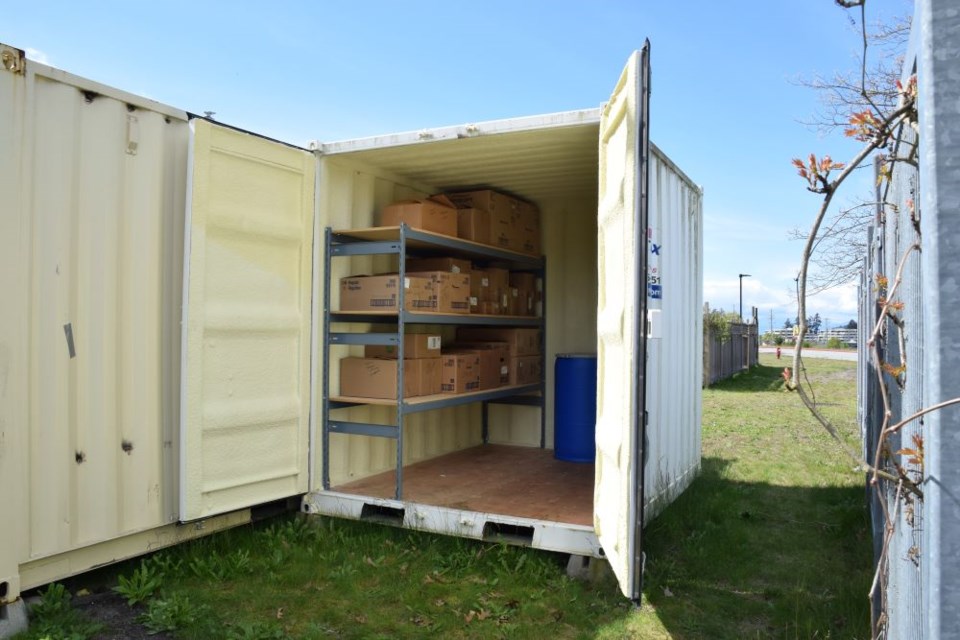In case a future emergency cuts off healthcare supplies from reaching a community, five rural areas in B.C. will have stored equipment at the ready — and they’re being kept in sea cans.
“You can think of it as a hospital-sized version of your emergency preparedness kit at home,” Health Emergency Management British Columbia’s (HEMBC) Scott Blessin told Coast Reporter.
On May 5, the Provincial Health Services Authority (PHSA) announced it is expanding a program that was launched before the pandemic. Several years ago, HEMBC (a PHSA program) added sea cans with supplies to Bella Coola and Bella Bella healthcare facilities, as the two remote communities face tsunami-related challenges. Sea cans were then added to Sechelt and Powell River hospitals. Now, a sea can container will be positioned at Fraser Canyon Hospital in Hope, bringing the total in this program up to five.
The 20-foot sea cans hold items such as additional hospital beds, sleeping cots, blankets, emergency food and water as well as other medical items. Sechelt and Powell River will be receiving more supplies for their containers.
Blessin said the sea cans are for some of the communities that are more likely to have transportation disruptions and need to have supplies on hand in emergencies and disasters. For Sunshine Coast communities, the lack of direct land routes had to potential transportation challenges as both Sechelt and Powell River rely on ferries or air transport to access or leave the area. In November, Hope — the newest location for the program — was completely isolated for 72 hours, Blessin said.
“There's certainly a recognition in our rural communities that we need to be able to strengthen and increase supplies to allow us to be more resilient, to have the capacity to last longer if the supply chains are disrupted, or if generally, people can't leave the hospital [or community],” Blessin said. The supplies could also be used for people in the community who have been displaced or need a warm place to stay, such as during a large power outage after a large-scale event.
While the program has always been in the works, Blessin said, “like a lot of things related to emergency management, we're very good at recognizing the risks after things have happened.”
Last year, Vancouver Coastal Health and Fraser Health faced three extremely large emergency responses. Following a heat dome, the summer of 2021 became one of the province’s three largest wildfire seasons (and more than 700 residents had to be evacuated from the Interior). While Blessin said he was happy to see the November rains — at first — the atmospheric rivers that followed caused mass transportation and shipping disruptions, flooding and landslides. Even though both have plenty of road access, Chilliwack General and Fraser Canyon Hospitals were cut off from key supply routes, and around 1,200 travellers became stranded.
So far, the sea can’s supplies at Sechelt Hospital have not had to be used, “fortunately,” Blessin said. The equipment is reviewed to ensure it’s still usable.
“To build resiliency takes a whole community approach,” Blessin wrote in an email. “While the health system is getting better prepared for emergencies we are only one part of the equation. We rely on individuals, local governments and organizations to get prepared as well so we are better able to support each other when the time comes.”
The expansion was announced during Emergency Preparedness Week (May 1 to 7), which encourages people to prepare themselves to last at least 72 hours without help in the case of an emergency. For people who don’t have a sea can of emergency supplies, Blessin recommends reviewing the supplies you do have, such as camping equipment, food and water, and make sure it’s easily accessible on short notice. People should also identify the hazards in their community and ensure they know what to do.
People should create emergency kits and “go bags” with the essentials, and Blessin recommends creating an emergency kit to keep inside vehicles. Blessin said a guide on extreme heat will be published by the province later this month.
More information and tips can be found at www.getprepared.ca.



